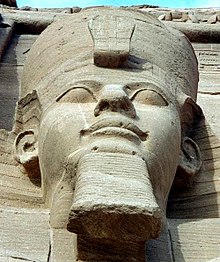Rameses II
| Ramesses II | |
|---|---|
| "Ramesses the Great" | |

One of the four external seated statues
of Ramesses II at Abu Simbel. |
|
| Pharaoh | |
| Reign | 1279–1213 BC (19th Dynasty) |
| Predecessor | Seti I |
| Successor | Merneptah |
| Consort | Nefertari, Isetnofret, Maathorneferure, Meritamen, Bintanath, Nebettawy, Henutmire |
| Children | Amun-her-khepsef, Ramesses, Pareherwenemef, Khaemwaset, Merneptah, Meryatum, Bintanath, Meritamen, Nebettawy, Henuttawy (List of children of Ramesses II) |
| Father | Seti I |
| Mother | Tuya |
| Born | c. 1303 BC |
| Died | 1213 BC (aged c. 90) |
| Burial | KV7 |
| Monuments | Abu Simbel, Abydos,Ramesseum, Luxor,Karnak |
Ramesses II (variously transliterated as "Rameses" (/ˈræməsiːz/) or "Ramses" (/ˈræmsiːz/ or /ˈræmziːz/); born c. 1303 BC; died July or August 1213 BC; reigned 1279–1213 BC), also known as Ramesses the Great, was the third pharaoh of the Nineteenth Dynasty of Egypt. He often is regarded as the greatest, most celebrated, and most powerful pharaoh of the Egyptian Empire. His successors and later Egyptians called him the "Great Ancestor". Ramesses II led several military expeditions into the Levant, reasserting Egyptian control over Canaan. He also led expeditions to the south, into Nubia, commemorated in inscriptions at Beit el-Wali and Gerf Hussein.
At age fourteen, Ramesses was appointed Prince Regent by his father Seti I. He is believed to have taken the throne in his late teens and is known to have ruled Egypt from 1279 BC to 1213 BC.Manetho attributes Ramesses II a reign of 66 years and 2 months; most Egyptologists today believe he assumed the throne on May 31, 1279 BC, based on his known accession date of III Shemu day 27. Estimates of his age at death vary; 90 or 91 is considered most likely. Ramesses II celebrated an unprecedented 14 sed festivals (the first held after thirty years of a pharaoh's reign, and then, every three years) during his reign—more than any other pharaoh. On his death, he was buried in a tomb in the Valley of the Kings; his body later was moved to a royal cache where it was discovered in 1881, and is now on display in the Cairo Museum.
...
Wikipedia
